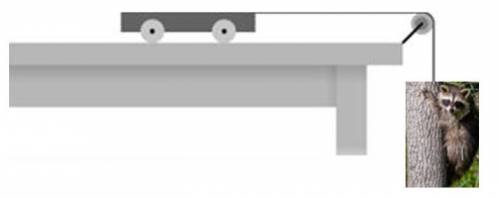
In the pulley arrangement shown, a 5.0 kg racoon (an animal sometime called a 'trash panda' because it is often found eating food in garbage cans) is hanging on a 1.0 kg log over the side of a table. They are attached to a cart of unknown mass, m. The racoon and the log are attached together (i. e. you consider them as though they are one object). The coefficient of friction between the cart and the table is 0.30. If the acceleration of the mass and cart is 2.0 ms2 .
a) Find the force of friction on the cart n terms of 'm' (m will be in your answer)
b) Solve for the cart's mass 'm'
c) Find the magnitude of tension in the string


Answers: 2
Another question on Physics

Physics, 22.06.2019 00:00
Astate of matter all that has define volume and can flow is a(n)
Answers: 3

Physics, 22.06.2019 11:50
The mass of the sun is 1.99×1030kg and its distance to the earth is 1.50×1011m. what is the gravitational force of the sun on the earth?
Answers: 3

Physics, 22.06.2019 13:10
A0.750 kg aluminum pan is removed from the stove and plunged into a sink filled with 10.0 kg of water at 293 k. the water temperature quickly rises to 297 k. what was the initial temperature of the aluminum pan? the specific heat of aluminum is ca = 900 j/(kgk) and water is cw = 4190 j/(kgk)
Answers: 3

Physics, 22.06.2019 17:00
In the future, people will only enjoy one sport: electrodisc. in this sport, you gain points when you cause metallic discs hovering on a field to exchange charge. you are an electrodisc player playing the popular four disc variant. the disks have charges of qa = −8.0 µc, qb = −2.0 µc, qc = +5.0 µc, and qd = +12.0 µc. (1) you bring two disks together and then separate them. you measure the resulting charge of these two disks and find that it is +5.0 µc per disk. which two disks did you bring together? (a) a and b (b) a and c (c)a and d (d)b and c(e) b and d (f) c and d. (2) you bring three disks together and then separate them. you measure the resulting charge of these three disks and find that it is +3.0 µc per disk. which three disks did you bring together? a, b, and c (a) a, b, and d (c) a, c, and d (d) b, c, and d. (3) given the resulting charge of each disk measured in (b) is +3.0 µc, how many electrons would you need to add to a disk of this charge to electrically neutralize it? electrons
Answers: 3
You know the right answer?
In the pulley arrangement shown, a 5.0 kg racoon (an animal sometime called a 'trash panda' because...
Questions

History, 30.07.2019 14:30

Chemistry, 30.07.2019 14:30

History, 30.07.2019 14:30


History, 30.07.2019 14:30






Social Studies, 30.07.2019 14:30

Social Studies, 30.07.2019 14:30



Social Studies, 30.07.2019 14:30

History, 30.07.2019 14:30

Social Studies, 30.07.2019 14:30

Mathematics, 30.07.2019 14:30

Social Studies, 30.07.2019 14:30

Mathematics, 30.07.2019 14:30




